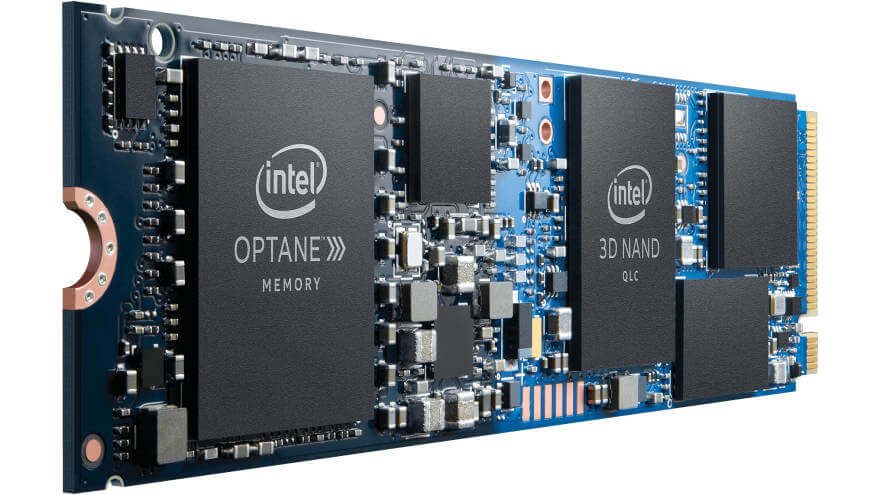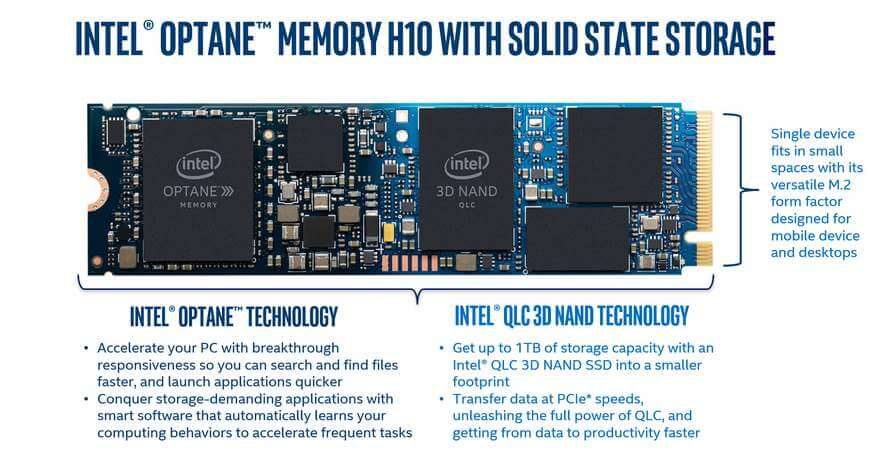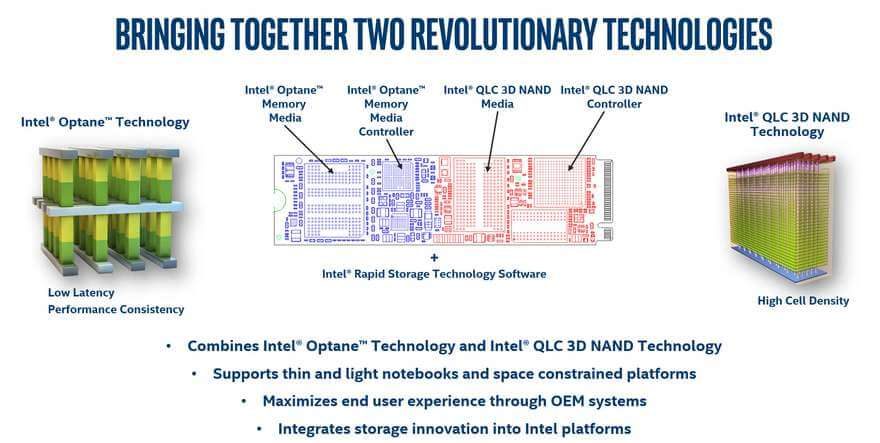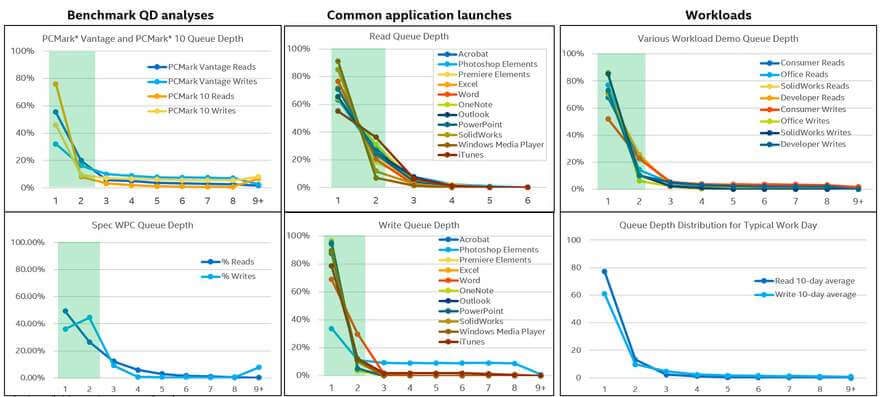Intel Optane Memory H10 Hybrid Storage Review
Bohs Hansen / 5 years ago

We’ve seen several drives come out of the house of Intel with the Optane branding already, but this new Optane Memory H10 is probably how we all wanted it from the beginning. It combines storage capacity with the responsiveness of Optane Memory in a single module. Easy to use, maximum effect.
Intel Optane Memory H10
The new Optane Memory H10 is a hybrid storage solution. It works on the same principles as SSHDs do. The drive features a combination of storage and memory for the best of both worlds. In the past, we had mechanical hard drives coupled with traditional NAND – but not anymore. Now we have NAND coupled with Intel’s 3D XPoint technology.
The new Intel Optane Memory H10 are located between the Optane Memory M10 and the Optane SSD 800P. With that in mind, we know that this isn’t a drive targeted at the enthusiasts and high-end gamers. Instead, it’s a way to get the most out of space-constrained systems.

Portable systems such as ultrabooks are the optimal target for these new Optane Memory H10 drives and they also the only place you’ll find these drives. At least in the beginning. I’m sure we’ll see them in NUC and other SFF systems too shortly. The issue here is that it hangs on the requirements of an 8th generation Intel Core U processor and an Intel 300-series chipset.
Performance and Endurance
Before we go any further, let us dive into the numbers for the Optane Memory H10. After all, I’m sure that’s one of the main reasons you openened up this post of ours.
The Optane Memory H10 delivers sequential read and write performance of 2400 and 1800 MB/s respectively. The low speeds here, when compared to high-end NVMe drives, is due to the fact that the drive only utilises 2 lanes for this part. The other 2 lanes are for the Optane Memory.

When it comes to the random performance rating, the drive might seem slow when you read other drive’s specs. But there’s a reason for that. While most drives advertise the performance at a queue depth of 32, the Optane does so for a QD of 1 and 2. The reason? Simple. This is the area where most common work tasks operate and it is also where the Optane memory really shines. A purpose built drive instead of one with magical figures. The drive delivers up to 32K/30K IOPS at QD1 random operations and 55K IOPS at QD2 operations.
The endurance is well-rated too on the Optane Memory H10. We get a 300 TBW rating and a 5-year warranty.
Why the CPU and Chipset Limitations?
When I first learned about the limitations during the pre-launch briefing, I was a little disappointed. I like things to be universally usable, that every person is able to pick exactly the parts they like and need for their type of work. But there’s a very good reason for it in the case of the Optane Memory H10.
First of all, we have the performance placement. It is designed to help productivity of office systems and content creators. Those tasks don’t require the best or the fastests, only something that’s great at those tasks. Mainstream gamers, Fornite, PUBG, CS:GO, LoL, DOTA, and similar games will all enjoy running from the Optane Memory H10.
The target for these drives are the really small systems. 13 to 15 inch systems that are very space restrained. Remember, everything from the motherboard to CPU and RAM, port controllers, and power delivery, it all has to be inside this tiny case. That means that there isn’t a lot of space left for the storage drive. Sure, the manufacturer can integrate it into the PCB, but that’s not optimal for several reasons. This is the situation where the Optane Memory H10 comes into play. It delivers what otherwise only was possible with M.2 drives in a single one. At the same time, it also offers a capacity not previously seen in the entry-level Optane products.
The Intel Optane Memory H10 will take this kind of systems to a whole new level where they joy of working with them will increase exponentially. The faster and more instant a system reacts to our input, the better.

Which Options Are There For You?
Intel is releasing the Optane Memory H10 in three options. The good news is that they all should perform equally, allowing you to pick the capacity based on the capacity you want.
It starts out with a moderate 16GB of Optane Memory coupled with 256GB of storage. From there it goes up to 32GB Optane Memory with wither 512GB or 1TB storage attached. I’ve got a system with the middle option in the office for this review. A nice sweet spot of 32GB impressive Crosspoint memory and 512GB of QLC 3D NAND.
How Does It All Work?
When we cut it down to basics, it is all a caching mechanism. The Optane Memory H10 identifies frequently accessed files and stores them in the 3D XPoint cache. This allows the system to search and find these files faster and thereby launch applications quicker. The software automatically adjusts the caching based on your habits, making sure that it fits your needs.
All the data is still stored on the SSD part of the drive. This part is made up of Intel QLC 3D NAND which allows a high capacity on a small footprint. It still delivers a great NVMe performance despite that, making the two a great combination.

What is 3D XPoint NAND?
The 3D XPoint technology, or crosspoint as it is pronounced, is the result of a cooperation between Intel and Micron. The Optane memory products are the first for consumers that utilise and benefit from this.
3D XPoint is designed to bridge the gap between non-volatile and volatile memory. Non-volatile is slower and cheaper (SSD), but it keeps the data stored even without power. Volatile is faster, but it will be cleared on power-loss (RAM).
Without going into too many details, it is essentially achieved by interconnecting all the cells instead of just sections. This allows for faster location of the section requested.
Feature Highlights
- Combination of Intel Optane and QLC 3D NAND Technology
- M.2 2280 single-sided module
- Advanced Caching Mechanisms for better system response
- 5-Year Warranty
- Up to 1TB capacity options
Specifications
You can check out the full specifications and available models on the official product page.




















